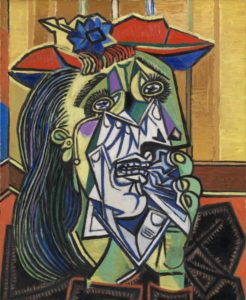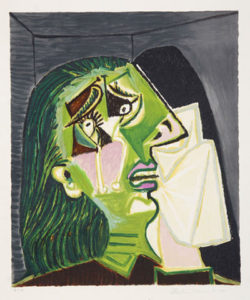
Weeping Woman,” 1937.
Everybody knows by now what a cad Picasso was in his love life. Biographical accounts, especially that by Arianna Stassinopoulos Huffington, have provided lots of tidbits: He once ground out a cigarette on a lover’s cheek, he encouraged two mistresses to have a fistfight over him, he dragged his wife across the floor by her hair.
All true? Who knows.
Such sordid revelations are almost standard fare in today’s “pathographies.” Most people recognize that the value of artists is in the art they produce, not in how they conduct their personal lives. However, there is always a point where art and biography intersect, where the life of the artist casts light on the work.
Some would have us believe that Picasso’s cubistic distortions of women’s bodies and faces revealed a deep-rooted misogynism. That’s like saying he hated music and wine because he distorted violins and wine bottles. Picasso’s career was devoted to the radical manipulation of form – whatever the subject.
Still, what was it about those crying women that fascinated Picasso? What made him push the face of grief to such extremes: gaping mouths, horselike teeth, knife-like tongues, eyes spilling tears like turned-over teacups?
Such is the subject of “Picasso and the Weeping Women,” at the Metropolitan Museum of Art. Originating at the Los Angeles County Museum of Art and expanded here for its New York showing, this is the first show ever to focus on this motif, which was among the themes that occupied Picasso from 1927 to 1943.
The subtitle of the show, “The Years of Marie-Therese Walter and Dora Maar,” refers to two of his major loves, neither of whom became his wife.

Walter was a 17-year-old schoolgirl when she met the 45-year-old painter. She became his mistress (his seduction of her reportedly involved visiting her at her summer camp) and their relationship gave rise to dozens of paintings that celebrate her voluptuousness and compliant passivity. In his nudes of her, she is all curves and circles, as soft as a pillow. The portraits, of which there are at least a dozen in the exhibit, present a face that is sweet, gentle, and uncomplicated.
Walter was no intellectual, and Picasso longed for another kind of mate as well. Although he didn’t entirely give up Walter, she was supplanted by Dora Maar, a surrealist photographer he met in 1936, when he was 54 and she was 28. Maar had an agile mind and a forceful personality. His portraits of her juxtapose dramatically with those of Walter. Maar is raven-haired and dark-eyed, with an air of power and intriguing complexity.
Although Picasso was to break both women’s hearts, the motif of the weeping women originated not from these relationships, but from a different sphere: the fascist atrocities in Spain. “Guernica,” painted in 1937, was probably his most famous work. The source was the bombing of the Basque city by the forces of General Francisco Franco. Maar apparently served as something of a mentor in the development of “Guernica” and photographed it in various stages of completion. The painting, executed in a highly ideographic style, shows victims and witnesses to the bombing. Of the several suffering women, one, a mother cradling her dead child, has that characteristic Picassoid expression of disfiguring grief – head thrown back, tongue thrust out of the gaping, tooth-lined mouth.
The image apparently intrigued Picasso, because he continued to experiment with it for months and years after “Guernica” was finished. Of course, 1937 was only the beginning of worldwide atrocities. In that context, the whole series might be seen as a metaphor for humanity’s suffering in World War II.
But, unlike the “Guernica” women, the ones he did afterward are portraits. There is no context for the suffering, political or otherwise. And this, combined with the fact that the faces sometimes resemble the women in his personal life – Dora Maar in particular – has led some people to conclude that the paintings are more personal than political.
For obvious reasons, the portrait has rarely been used as a vehicle for depicting the atrocities of war. But Picasso, it must be remembered, remained in France during the occupation, under the watchful eye of the Nazis. He was left alone for the most part, protected by his fame, but one wonders what his fate would have been if his paintings of weeping women depicted Nazi soldiers as their tormentors.
Picasso, ever-productive, painted through the war years and emerged fully intact. For Maar it was a different story: Half-Jewish, and politically idealistic in a way that Picasso wasn’t, she became progressively unstable and, by the end of the war, suffered a complete breakdown and underwent electroshock therapy.

Dora Maar self-portrait.
Many of the suffering women are recognizable as Maar, including the masterpiece, Weeping Womanoman” (1937), in which the tortured subject, despite a cheerful red bonnet, looks as if she had encountered some unspeakable horror on a Sunday afternoon stroll. Her face is composed of jagged forms, she bites on a white handkerchief, and her eyes resemble capsizing boats.
This exhibit is a lexicon of grief. Among the other features Picasso manipulated to depict this extreme emotion are teeth, tongues, tears, nostrils, splayed fingers, and bodies enmeshed in rope coils. Almost all the victims are grotesque. Their tragedy is not the ennobling sort.
The weakest works are those in which the grotesque becomes caricature, as in those where Picasso attempts to give anatomical detail to the cubist distortions. The results are monsters with repulsive snouts, inhuman mandibles, and other facial protrusions that take us into a realm so bizarre it goes beyond suffering or tragedy.
Critics sometimes portray Maar as a feminist martyr, a strong, independent woman, an artist in her own right, turned into a doormat by the sadistic Picasso. Picasso himself claimed that he gave Maar a tortured appearance “not out of sadism, and without any pleasure on my part, but in obedience to a vision that had imposed itself upon me.”
Maar, for her part, dismissed the biographical relevance of the portraits: “They’re all Picassos, not one is Dora Maar. … Do you think I care? Does Madame Cezanne care? Does Saskia Rembrandt care?”
The last painting of her, done fairly realistically, is particularly poignant. Her eyes are hollow, haunting; she looks bereaved, finished, burned out. She was 34.

